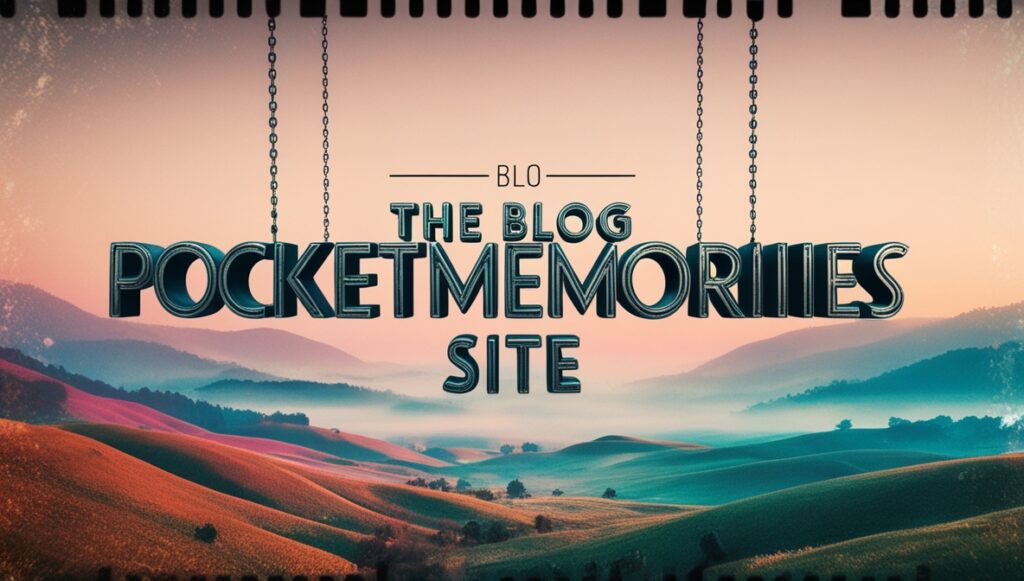What if you could bottle up memories? Not the kind that fade or get lost in old phones or forgotten hard drives.
But something that sticks. That stays. That’s what the blog PocketMemoriesNet site is all about—it’s not just a site. It’s a memory keeper.
It’s a digital scrapbook, a story vault, a timeline, and a personal museum—all in one.
So, What Is the Blog PocketMemoriesNet Site, Anyway?
In a sentence?
It’s a platform that helps you capture, organize, and share your memories—the way you actually lived them.
Whether you’re a family wanting to track milestones, a solo traveler recording epic sunsets, or a collector who wants to document every vinyl record or spoon you’ve picked up—this space was made for that.
At its core, it’s a blog-style memory journal.
But it’s been built with way more soul than your average blog platform.
The layout, tools, and experience on PocketMemoriesNet are designed for humans—not just “content creators.”
The Blog PocketMemoriesNet Site: What Can You Actually Do?
Let’s look under the hood a bit.
Here are some standout features that make this memory machine tick:
- Chronological Story Timeline
Easily arrange posts by date, event, or even mood (yeah, really). - Multimedia Uploads
Photos, voice notes, videos, and even scanned old letters or journal pages. - Tag-Based Memory Sorting
Organize entries by people, places, themes, objects—whatever helps you remember better. - Collaborative Memory Spaces
Create shared albums or memory timelines with your family, friends, or creative teams. - Private/Public Toggle
Choose who sees what. Lock it down or open it wide. You control the memory gate. - Memory Maps
Pin memories to maps so you can see where life took you (literally).
Real Talk:
PocketMemoriesNet is what you get when Google Photos and Medium had a baby, and that baby actually cared about your feelings.
Why Use PocketMemoriesNet?
Because we forget too much.
Because memory is fragile.
And because traditional blogging or journaling doesn’t really get how layered real memories are.
Here’s why it stands out:
- It’s Emotionally Aware
The platform encourages you to include emotion tags.
“Happy”, “bittersweet”, “grateful”, “lonely”—real memory vibes, not just filters. - It’s Not About Likes
You’re not chasing clout here. You’re preserving something real.
This is about impact, not impressions. - You Can Revisit in New Ways
Random memory generator? Yes. AI-assisted memory compilations? Also yes.
Sometimes the platform knows what you need to remember, even when you forget it yourself.
PocketMemoriesNet Benefits That People Don’t Talk About Enough
Here’s what you get once you dive in:
- Therapeutic Reflection
Writing about your life isn’t just memory keeping—it’s therapy. - Legacy Creation
You’re building a time capsule. For your kids. Your grandkids. Your future self. - Digital Clarity
Finally, one place where your memories aren’t buried under junk. - Community Without Chaos
It’s not a social media echo chamber. It’s calm. Thoughtful. Human.
Let’s be real—scrolling through Instagram is not the same as actually preserving your memories.
Starting Out: How to Begin Your Journey on PocketMemoriesNet

Okay, let’s break it down:
Step 1: Create Your Account
It’s dead simple.
Email, username, password. Done.
You don’t even need to pick a theme yet—just start writing.
Pro tip? Choose a username that reflects your story. Not your brand. You’re not selling anything here.
Step 2: Personalize Your Profile
Upload a photo.
Write a small bio that sounds like you—not a LinkedIn pitch.
Add a little quote or even a song that captures your vibe.
Small touches make it your space.
Step 3: Explore the Dashboard
This is where it gets fun.
You’ll see:
- “New Memory” Button
- Tags and Filters Section
- “Memory Map”
- Shared Memory Circles
- Draft Vault
Click around. Don’t be shy.
Who Should Really Be Using This Blog PocketMemoriesNet Site?
Honestly? Everyone.
But if we’re being specific, here’s who thrives on it:
Families
Capture every first step, every lost tooth, every weird crayon drawing.
And instead of storing them in a dusty folder, you’re creating a memory timeline that tells a story.
Shared family spaces also mean Grandma can see it without a Facebook account.
Travelers
Document each country, every hike, every mishap at the airport.
Geo-tag posts.
Upload passport stamps.
Embed Google Maps.
Tell the story behind the photo, not just the coordinates.
Hobbyists & Creatives
Writers, knitters, bakers, collectors—this is your cozy corner.
Chronicle progress.
Store notes.
Track inspiration.
Think Pinterest, but without the algorithm noise.
How to Write Better on PocketMemoriesNet: Tips from Pros
Don’t just write. Write well. Here’s how:
Use Real Storytelling Techniques
Start with a hook.
Drop into the moment.
Use your senses.
Even a post about your garden can become a miniature novel if you do it right.
“The tomatoes were stubborn this year. Just like my grandmother.”
Boom—memory magic.
Add Visuals That Mean Something
Don’t just dump photos. Caption them.
Why was that moment worth capturing?
Tables like this can help too:
| Memory Type | Ideal Media Format | Additions |
|---|---|---|
| Family Event | Photos + Voice Memos | Quotes from the day |
| Travel Log | Map + Video | Location stats |
| Personal Reflection | Text + Ambient Sound | Mood tags |
Ask Questions in Your Posts
Invite others to chime in.
Not for engagement. But for connection.
“What did your childhood kitchen smell like?”
Watch the stories come pouring in.
What Makes PocketMemoriesNet Actually Different?
It’s not just features. It’s vibe.
It’s Built Around Community, Not Popularity
No follower counts. No viral bait.
Just quiet, genuine connection.
You can make your memory journal public. Or just keep it between a few friends.
The Experience Is Tailored to You
AI suggests ways to organize, connect, or re-discover your memories.
Over time, it learns what kind of stories you tend to tell.
Think of it as your digital archivist.
Strong Privacy Controls
You choose:
- Who sees what
- Which memories are shareable
- Whether content gets indexed or not
In a world of oversharing, this is your understated safe space.
Need Ideas? Here’s What to Write About on PocketMemoriesNet
Memory drought is real. Try these:
- “The last meal I cooked with my mom.”
- “What my dog taught me about patience.”
- “The weirdest item in my junk drawer and why I’m keeping it.”
- “My favorite photo from college and the story behind it.”
Or use these prompts:
| Prompt Type | Example |
|---|---|
| Emotion-Based | “A day I felt pure joy” |
| Sensory Trigger | “The smell of old books” |
| Object Memory | “This old watch and what it saw” |
Staying Organized on the Blog PocketMemoriesNet Site
When your memory library starts growing, don’t panic.
Use Content Organization Tools
Tags, categories, folders—you name it.
Label memories by year, people, themes, moods.
Manage Your Drafts
Sometimes memories take time to unpack.
Save them. Revisit them.
There’s no rush here.
Why Memory Keeping Matters More Than Ever
This isn’t just nostalgia. It’s science.
The Psychology of Memory Preservation
Studies show that documenting memories improves emotional regulation, clarity, and long-term happiness.
Journaling helps organize thought patterns.
Memory sharing builds bonds.
You’re Building Your Own Legacy
When you post, you’re not just writing for now.
You’re writing for the future you. And for the people who’ll miss you one day.
“Your memory is the architecture of your soul.” — Unknown
And this blog PocketMemoriesNet site is the place to start building that structure.
Final Thoughts
If you’ve ever said, “I wish I wrote that down,” then PocketMemoriesNet is for you.
It’s more than a blog.
More than a tool.
It’s where your life goes to be remembered—the way you meant it to be.
Don’t wait till it’s too late to start preserving what really matters.
So go ahead.
Open a memory. Write it down. Keep it forever.





